英语作文-东西方文化差异 -Cultural differences
- 格式:doc
- 大小:26.50 KB
- 文档页数:2
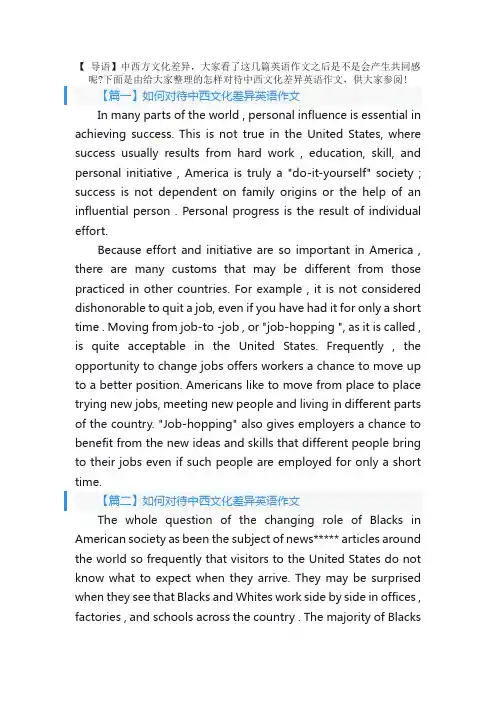
【导语】中西方文化差异,大家看了这几篇英语作文之后是不是会产生共同感呢?下面是由给大家整理的怎样对待中西文化差异英语作文,供大家参阅!【篇一】如何对待中西文化差异英语作文In many parts of the world , personal influence is essential in achieving success. This is not true in the United States, where success usually results from hard work , education, skill, and personal initiative , America is truly a "do-it-yourself" society ; success is not dependent on family origins or the help of an influential person . Personal progress is the result of individual effort.Because effort and initiative are so important in America , there are many customs that may be different from those practiced in other countries. For example , it is not considered dishonorable to quit a job, even if you have had it for only a short time . Moving from job-to -job , or "job-hopping ", as it is called , is quite acceptable in the United States. Frequently , the opportunity to change jobs offers workers a chance to move up to a better position. Americans like to move from place to place trying new jobs, meeting new people and living in different parts of the country. "Job-hopping" also gives employers a chance to benefit from the new ideas and skills that different people bring to their jobs even if such people are employed for only a short time.【篇二】如何对待中西文化差异英语作文The whole question of the changing role of Blacks in American society as been the subject of news***** articles around the world so frequently that visitors to the United States do not know what to expect when they arrive. They may be surprised when they see that Blacks and Whites work side by side in offices , factories , and schools across the country . The majority of Blacksin the United States, however, live in and around only a small number of American cities.Many dark-skinned visitors arrive in the United States fearing personal attack or expecting various degrees of racial prejudice. Some forms of discrimination [1] still exist ,unfortunately, especially in the areas of the housing , schools , and jobs . The school equality is still more a dream than a reality. There are still too many areas of the country where Black Americans do not enjoy the same full opportunities as White Americans . However, the vast majority of American s are working , studying , and sharing public places together. This was not true even a few years ago in some parts of the country , but progress is steadily being made . You will be able to observe the improvement in race relations as soon as your plane lands . You will see it in the airport, in public buses and trains , in theaters , restaurants , rest room, in sops and libraries , in offices and factories . Close personal friendships between Blacks and Whites , full trust and social relationships are still not common , except in certain areas, However, even in this - the slowest area of progress-there has been change , especially among young people.【篇三】如何对待中西文化差异英语作文In many nations , everyday activities are done in a planned , orderly manner. For example , formal relationships among people may be determined according to customs and habits that have existed for a long time . People visiting an informal country , such as the United States , may find that the American belief in personal initiative or ******* (including the ******* to disagree with those in authority ), and the whole economic system is quits confusing and uncontrolled . To some visitors such *******s are too "loose" and too disorganized to be comfortable.Today the United States i* **periencing great change in every part of society ;therefore life in America may indeed seem confused . Social attitudes are being questioned Americans are wondering: "Is there any morality ?" "Why has the nation never given all of its citizens full opportunity ?""What courses should be taught in school?" "What is the role of women in society ? "As visitors , you will notice that some Americans are beginning to leave the cities and make their homes in small cities and towns where life is quieter and slower . Political beliefs are changing . The kinds of skills needed by workers today differ from those in demand several years ago.【篇四】如何对待中西文化差异英语作文Just as the degree of individual ******* that exists in America seems loose and therefore uncomfortable to many visitors . In many countries , people will tell you what they think you want to here , whether or not it is true. To them , this is the polite thing to do. To Americans it is considered confusing -even dishonest -to avoid telling the true facts. even if avoiding the truth is done only to be polite . It is helpful to remember that different cultures consider some matters more important than others . Wit Americans , however, trust and truth are most important. One of the worst tings that can be said about someone in America is that " you cannot trust him"Considering such differences in values among the many cultures of the world , it is natural that misunderstandings [1] will occur . "How far is it to the next town ?" an American asks a man standing by the edge of a road . In some countries , because the man realizes the traveler is tired and eager to reach the next village, he will politely say , ' Just down the road ". e thinks this is more encouraging ., gentler , and therefore the answer thetraveler wants to hear. So the American drives alone for many more hours before he comes to the village. The traveler is angry , feeling "tricked". He thinks that the man has purposely lied to him because he must have know quite will well what the distance was.If a visitor to the United States asked an American standing at the edge of a road how far the next town was, the American would think it dishonest if he said it was near when he knew it was really 24 miles away. Although he , too , would be sympathetic with the tired traveler , he would say, "You have a long way to go yet ; it is at least 24 miles more. " The traveler might be disappointed , but he would know what to expect, and there would be no misunderstanding.。
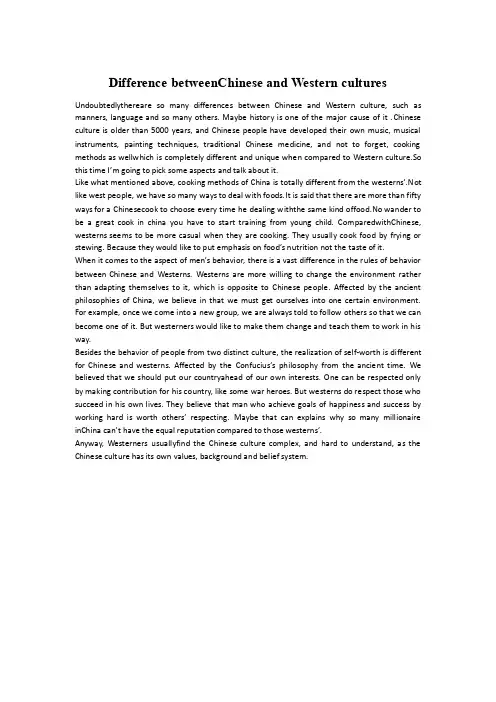
Difference betweenChinese and Western culturesUndoubtedlythereare so many differences between Chinese and Western culture, such as manners, language and so many others. Maybe history is one of the major cause of it .Chinese culture is older than 5000 years, and Chinese people have developed their own music, musical instruments, painting techniques, traditional Chinese medicine, and not to forget, cooking methods as wellwhich is completely different and unique when compared to Western culture.So this time I’m going to pick some aspects and talk about it.Like what mentioned above, cooking methods of China is totally different from the westerns’.N ot like west people, we have so many ways to deal with foods.It is said that there are more than fifty ways for a Chinesecook to choose every time he dealing withthe same kind offood.No wander to be a great cook in china you have to start training from young child. ComparedwithChinese, westerns seems to be more casual when they are cooking. They usually cook food by frying or stewing. Because they would like to put emphasis on food’s nutrition not the taste of it.When it comes to the aspect of men’s behavior, there is a vast difference in the rules of behavior between Chinese and Westerns. Westerns are more willing to change the environment rather than adapting themselves to it, which is opposite to Chinese people. Affected by the ancient philosophies of China, we believe in that we must get ourselves into one certain environment. For example, once we come into a new group, we are always told to follow others so that we can become one of it. But westerners would like to make them change and teach them to work in his way.Besides the behavior of people from two distinct culture, the realization of self-worth is different for Chinese and westerns. Affected by the Confucius’s philosophy from the ancient time. We believed that we should put our countryahead of our own interests. One can be respected only by making contribution for his country, like some war heroes. But westerns do respect those who succeed in his own lives. They believe that man who achieve goals of happiness and success by working hard is worth others’ respecting. Maybe that can explains why so many millionaire inChina can’t have the equal reputation compared to those westerns’.Anyway, Westerners usuallyfind the Chinese culture complex, and hard to understand, as the Chinese culture has its own values, background and belief system.。
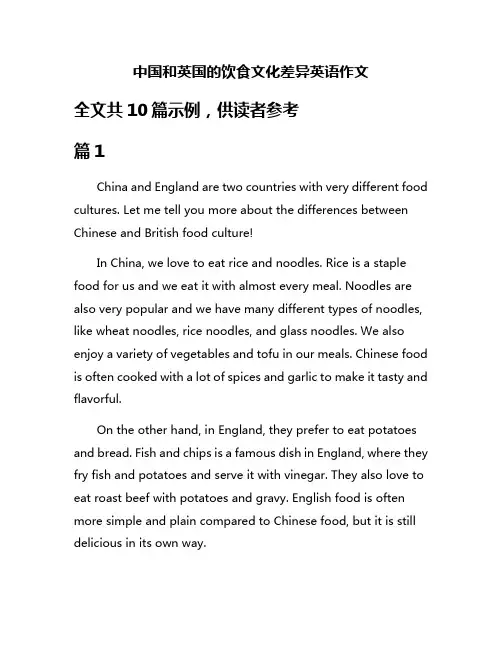
中国和英国的饮食文化差异英语作文全文共10篇示例,供读者参考篇1China and England are two countries with very different food cultures. Let me tell you more about the differences between Chinese and British food culture!In China, we love to eat rice and noodles. Rice is a staple food for us and we eat it with almost every meal. Noodles are also very popular and we have many different types of noodles, like wheat noodles, rice noodles, and glass noodles. We also enjoy a variety of vegetables and tofu in our meals. Chinese food is often cooked with a lot of spices and garlic to make it tasty and flavorful.On the other hand, in England, they prefer to eat potatoes and bread. Fish and chips is a famous dish in England, where they fry fish and potatoes and serve it with vinegar. They also love to eat roast beef with potatoes and gravy. English food is often more simple and plain compared to Chinese food, but it is still delicious in its own way.Another difference is that in China, we like to eat our meals with chopsticks, while in England, they use fork and knife. It can be a bit tricky to use chopsticks at first, but once you get the hang of it, it's really fun!Overall, both Chinese and British food cultures have their own unique flavors and traditions. It's interesting to see how different countries have different ways of preparing and enjoying food. Whether you prefer Chinese noodles or British fish and chips, there's something for everyone to enjoy!篇2China and Britain are two countries with very different food cultures. Let's take a look at some of the differences between Chinese and British food cultures.In China, people eat a lot of rice. Rice is a staple food in China, and it is served with almost every meal. In Britain, on the other hand, people eat a lot of bread. Bread is a staple food in Britain, and it is served with almost every meal.In China, people eat a lot of vegetables. Vegetables are a big part of Chinese cuisine, and they are usually stir-fried or steamed. In Britain, people eat a lot of meat. Meat is a big part of British cuisine, and it is usually roasted or grilled.In China, people eat a lot of noodles. Noodles are a popular dish in China, and they are served in many different ways. In Britain, people eat a lot of potatoes. Potatoes are a popular dish in Britain, and they are served boiled, mashed, or fried.In China, people drink a lot of tea. Tea is a big part of Chinese culture, and it is served with almost every meal. In Britain, people drink a lot of tea too, but they also drink a lot of coffee. Coffee is a big part of British culture, and it is served with almost every meal.Overall, the food cultures of China and Britain are very different. Each country has its own unique dishes and traditions, which make eating in China and Britain a truly special experience.篇3Oh, hi there! Today I'm gonna talk about the differences between Chinese and British food culture. It's gonna be super interesting, trust me!So, in China, food is like super important. We have so many delicious dishes like dumplings, noodles, and rice. We love to eat together with our family and friends, and we always make sure there's enough food for everyone. And we use chopsticks to eat, which is totally cool!But in Britain, they have different food culture. They love their tea and scones, and fish and chips. They also have this thing called a roast dinner, where they eat roast meat like chicken or beef with potatoes and veggies. And they like to have a cup of tea with milk in the afternoon, which is kinda weird but also kinda nice.Another big difference is the way we eat. In China, we like to eat our food hot and fresh, and we use a lot of spices and sauces to make it tasty. But in Britain, they prefer their food more plain and simple, without too many seasonings. They also eat a lot of bread and cheese, which we don't really have in China.Overall, both Chinese and British food cultures are super cool in their own way. It's really interesting to see how different countries have their own unique food traditions. I hope you learned something new today! Thanks for reading, bye!篇4Oh, hi everyone! Today I want to talk about the differences between Chinese and British food culture! It's super interesting, trust me!First of all, let's talk about breakfast. In China, we love to eat congee, fried dough sticks, and steamed buns for breakfast. It'sso yummy! But in the UK, they usually have cereal, toast, and maybe some eggs and bacon. It's quite different, right?Next, let's talk about tea time. In China, we like to have tea and maybe some snacks like dumplings or mooncakes. But in the UK, they have afternoon tea with scones, sandwiches, and cakes. It's so fancy!And for dinner, Chinese people usually eat rice or noodles with veggies and meat. We love to share dishes with our family and friends. But in the UK, they might have roast beef with potatoes and gravy. It's a big meal!Oh, and don't forget about desserts! In China, we have sweet treats like red bean buns and mango pudding. But in the UK, they love their puddings like sticky toffee pudding and apple crumble. It's so tasty!So, you see, there are lots of differences between Chinese and British food culture. But both countries have delicious food that you should try! Maybe you can have a Chinese takeaway one day and then try some traditional British dishes the next. It's a tasty adventure!That's all for now, see you next time! Bye bye!篇5Hello everyone! Today I'm going to talk about the differences between Chinese and British food culture.First of all, let's talk about Chinese food. Chinese people love to eat rice, noodles, and lots of vegetables. We also like to eat a lot of different types of meat, like pork, beef, and chicken. Some popular Chinese dishes include dumplings, fried rice, and hot pot. We also have a tradition of drinking tea with our meals.On the other hand, British food is quite different. British people love to eat things like fish and chips, roast beef with Yorkshire pudding, and bangers and mash. They also love to eat desserts like scones with clotted cream and jam, and sticky toffee pudding. British people often drink tea with milk, or coffee with their meals.Another big difference between Chinese and British food culture is the way meals are served. In China, we usually have a family-style meal, where everyone shares dishes. In Britain, meals are served in courses, starting with a starter, then a main course, and finally dessert.Overall, both Chinese and British food cultures are unique and delicious in their own ways. It's fun to try new foods from different cultures and see how they differ from the food we'reused to. I hope you enjoyed learning about these differences! Thanks for reading!篇6Hey guys! Today, let's talk about the differences between Chinese and British food culture. Are you ready? Let's go!First of all, let's talk about Chinese food. In China, people love to eat rice and noodles. We also eat a lot of vegetables and fruits. Chinese food is very diverse and each region has its own special dishes. Some famous Chinese dishes are dumplings, Kung Pao chicken, and Peking duck. Yum!On the other hand, British food is quite different. In Britain, people eat a lot of meat and potatoes. Some popular British dishes are fish and chips, roast beef, and shepherd's pie. In Britain, people also love to drink tea. Afternoon tea is a very popular tradition in Britain.Another difference between Chinese and British food culture is the way meals are served. In China, meals are servedfamily-style, which means that everyone shares dishes. In Britain, meals are served individually, with each person getting their own plate of food.Overall, Chinese and British food cultures are quite different but both are delicious in their own way. So next time you have the chance, try some Chinese and British food and see which one you like better. Bon appétit!篇7Hey guys! Today, let's talk about the differences between Chinese and British food culture. It's super interesting, so listen up!First of all, let's talk about Chinese food. In China, we love to eat rice, noodles, and dumplings. And oh my goodness, the flavors are out of this world! We have so many different dishes with yummy sauces and spices. Plus, we eat with chopsticks, which is so fun!But in Britain, they love their fish and chips. Can you believe it? They fry fish and potatoes and eat it with vinegar. It's totally different from our food, but I bet it's tasty too. And they use knives and forks to eat, not chopsticks like us.Another big difference is the way we eat together. In China, we love to share dishes with our family and friends. It's all about sharing and caring. But in Britain, everyone has their own plate of food. They don't share like we do.And don't even get me started on dessert! In China, we have sweet buns, rice cakes, and fruit for dessert. But in Britain, they love their puddings like apple crumble and custard. It's so different from what we eat, but I bet it's delicious.Overall, Chinese and British food cultures are so different, but both are amazing in their own way. So let's keep enjoying all the tasty food from around the world!That's all for today, guys. I hope you learned something new about Chinese and British food culture. Bye!篇8China and the UK are two countries with very different food cultures. In China, we love to eat rice, noodles, and dumplings. These are some of our staple foods that we eat almost every day. We also enjoy dishes like Kung Pao chicken, Peking duck, and hot pot. These dishes are full of flavor and very delicious.In the UK, people eat a lot of different foods than we do in China. They love to eat fish and chips, roast beef, and shepherd's pie. They also enjoy desserts like scones, Victoria sponge cake, and trifle. The food in the UK is quite different from what we are used to, but it is still very tasty.One big difference between Chinese and British food culture is the way we eat our meals. In China, we like to eat family-style, where everyone shares dishes from the middle of the table. This creates a sense of community and togetherness. In the UK, people tend to eat their own individual meal without sharing. This can sometimes feel a bit lonely, but it is just a different way of eating.Another difference is the use of spices and seasonings. Chinese food is often very flavorful and spicy, with lots of garlic, ginger, and soy sauce. British food, on the other hand, is more subtle in its flavors, with a focus on herbs like parsley and thyme. Some people in the UK find Chinese food too spicy, while some Chinese people may find British food a bit bland.Overall, both Chinese and British food cultures have their own unique flavors and traditions. It is interesting to learn about the differences and similarities between the two, and to try new foods from different cultures. Food is a big part of our lives, and it is a great way to connect with people from around the world. Let's keep enjoying delicious food together!篇9China and Britain have very different food cultures. Let me tell you about the differences!First of all, in China, we love to eat rice as our staple food. Rice is the most important part of our meals. We also eat a lot of noodles, dumplings, and steamed buns. These foods are delicious and very filling. In Britain, they eat a lot of bread and potatoes. They love to have sandwiches for lunch and potatoes with their meals. They also enjoy fish and chips, which is a popular dish in Britain.Another big difference is the way we eat our meals. In China, we use chopsticks to eat our food. Chopsticks are long, thin sticks that we use to pick up our food. In Britain, they use knives and forks to eat. They cut their food into small pieces and then use their forks to eat. It's very different from how we eat in China!In China, we also have a lot of different types of tea that we drink with our meals. We have green tea, black tea, oolong tea, and many other varieties. In Britain, they drink a lot of black tea with milk and sugar. They also love to have afternoon tea with sandwiches and scones.Overall, China and Britain have very different food cultures. But both countries have delicious and unique dishes that areloved by their people. It's fun to learn about the food traditions of different countries!篇10Chinese and British food cultures are different in many ways. Let's explore these differences and see how they make each country's food unique!In China, we love noodles, dumplings, and rice. Noodles can be found in all shapes and sizes, and we like to slurp them up quickly. Dumplings are stuffed with meat or vegetables and are boiled or fried. They are so yummy! Rice is a staple food in China, and we eat it with almost every meal.On the other hand, in Britain, they love their fish and chips. Fish is usually battered and deep-fried, served with crispy fries. It's a popular dish that you can find at many pubs and restaurants. They also enjoy their pies, like meat pies or shepherd's pies. They are hearty and delicious!Chinese people enjoy tea with their meals, while British people prefer a cup of black tea or coffee. Both countries have their own unique desserts too. In China, we have sweet red bean soup or tangyuan (glutinous rice balls). In Britain, they love their scones with clotted cream and jam, or sticky toffee pudding.Overall, both Chinese and British food cultures have their own specialties and flavors that make them special. It's fun to try new foods from different countries and see how they can be so different yet so delicious! Let's celebrate the diversity in food cultures and enjoy the tasty dishes each country has to offer. Yum yum!。
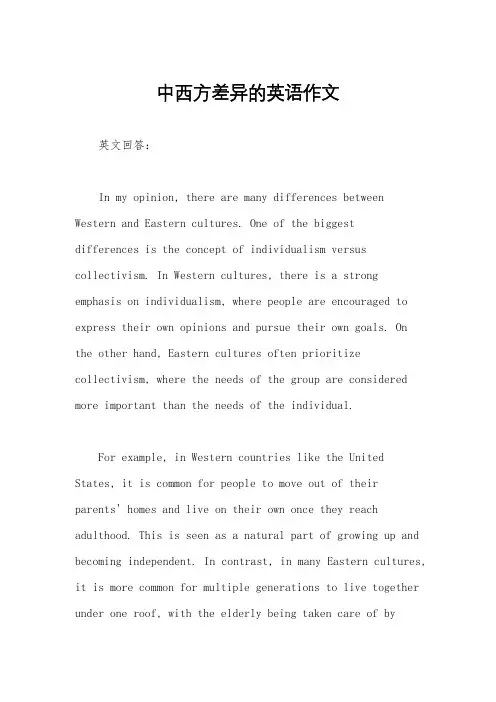
中西方差异的英语作文英文回答:In my opinion, there are many differences between Western and Eastern cultures. One of the biggestdifferences is the concept of individualism versus collectivism. In Western cultures, there is a strong emphasis on individualism, where people are encouraged to express their own opinions and pursue their own goals. On the other hand, Eastern cultures often prioritize collectivism, where the needs of the group are considered more important than the needs of the individual.For example, in Western countries like the United States, it is common for people to move out of theirparents' homes and live on their own once they reach adulthood. This is seen as a natural part of growing up and becoming independent. In contrast, in many Eastern cultures, it is more common for multiple generations to live together under one roof, with the elderly being taken care of bytheir children and grandchildren.Another difference is the communication style. In Western cultures, people tend to be more direct and assertive in their communication, often expressing their opinions openly and honestly. In Eastern cultures, there is often a greater emphasis on politeness and indirect communication, with people being more likely to use subtle hints and nonverbal cues to convey their thoughts and feelings.Furthermore, the perception of time also differs between the two cultures. In Western cultures, time is often seen as a limited resource that needs to be managed efficiently. People are expected to be punctual and adhere to schedules. In contrast, in many Eastern cultures, time is viewed as more fluid and flexible, with less emphasis on strict adherence to schedules.中文回答:在我看来,东西方文化之间存在许多差异。
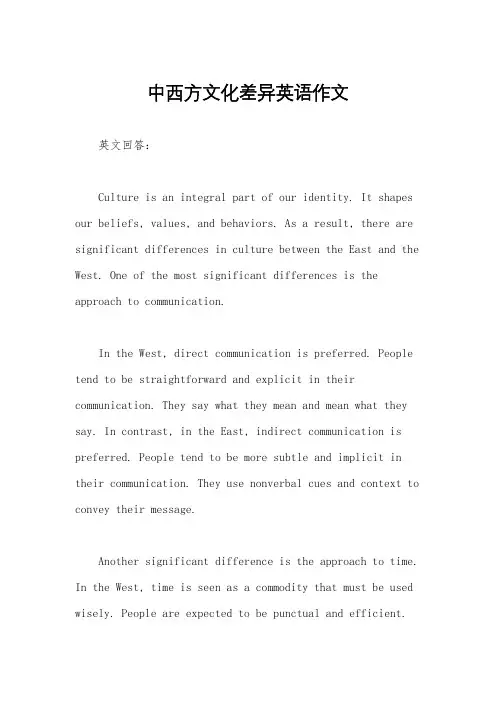
中西方文化差异英语作文英文回答:Culture is an integral part of our identity. It shapes our beliefs, values, and behaviors. As a result, there are significant differences in culture between the East and the West. One of the most significant differences is the approach to communication.In the West, direct communication is preferred. People tend to be straightforward and explicit in their communication. They say what they mean and mean what they say. In contrast, in the East, indirect communication is preferred. People tend to be more subtle and implicit in their communication. They use nonverbal cues and context to convey their message.Another significant difference is the approach to time. In the West, time is seen as a commodity that must be used wisely. People are expected to be punctual and efficient.In contrast, in the East, time is seen as a more fluid concept. People are less concerned with punctuality and more concerned with building relationships and establishing trust.These differences can lead to misunderstandings and miscommunication between people from different cultures. It is essential to be aware of these differences and to adapt one's communication style accordingly.中文回答:文化是我们身份认同的重要组成部分。
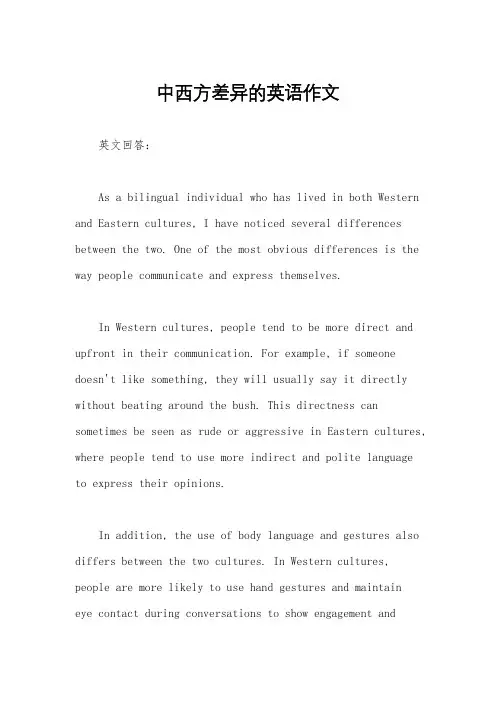
中西方差异的英语作文英文回答:As a bilingual individual who has lived in both Western and Eastern cultures, I have noticed several differences between the two. One of the most obvious differences is the way people communicate and express themselves.In Western cultures, people tend to be more direct and upfront in their communication. For example, if someone doesn't like something, they will usually say it directly without beating around the bush. This directness can sometimes be seen as rude or aggressive in Eastern cultures, where people tend to use more indirect and polite languageto express their opinions.In addition, the use of body language and gestures also differs between the two cultures. In Western cultures, people are more likely to use hand gestures and maintaineye contact during conversations to show engagement andinterest. On the other hand, in Eastern cultures, people may use more subtle gestures and avoid direct eye contact as a sign of respect.Furthermore, the concept of time is another area where the two cultures differ. In Western cultures, time is often seen as a limited resource, and punctuality is highly valued. People are expected to be on time for appointments and meetings. In contrast, in Eastern cultures, time is more fluid, and being a few minutes late is often not a big deal.Another notable difference is the attitude towards personal space. In Western cultures, people tend to have a larger personal space bubble and may feel uncomfortable with too much physical proximity. In Eastern cultures, however, people are more accustomed to being in close physical proximity and may not feel the same level of discomfort.中文回答:作为一个能说两种语言的人,在西方和东方文化中生活过的我,注意到了两者之间的一些差异。
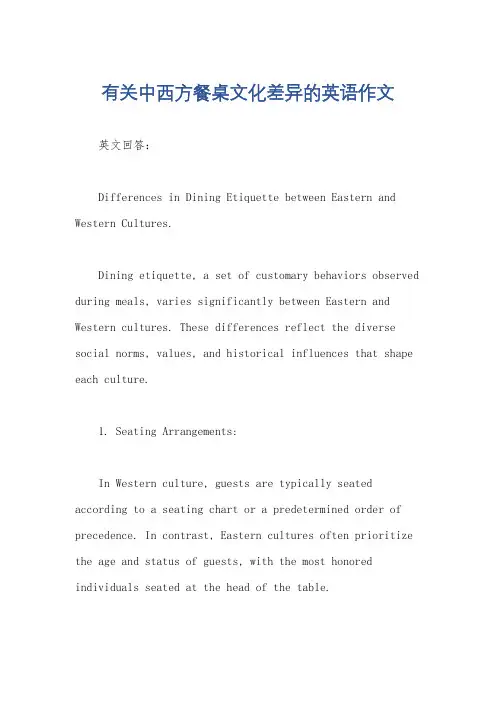
有关中西方餐桌文化差异的英语作文英文回答:Differences in Dining Etiquette between Eastern and Western Cultures.Dining etiquette, a set of customary behaviors observed during meals, varies significantly between Eastern and Western cultures. These differences reflect the diverse social norms, values, and historical influences that shape each culture.1. Seating Arrangements:In Western culture, guests are typically seated according to a seating chart or a predetermined order of precedence. In contrast, Eastern cultures often prioritize the age and status of guests, with the most honored individuals seated at the head of the table.2. Table Manners:Western etiquette dictates that utensils be held in a specific manner, with the fork in the left hand and the knife in the right. Food is cut into small pieces before being eaten. In Eastern cultures, chopsticks are the primary utensils, and food is typically shared from communal platters.3. Toasting:Toasting is a common practice in Western dining to honor guests or celebrate special occasions. In contrast, toasting is less prevalent in Eastern cultures, where it is often considered less respectful to raise one's glass in celebration while others are still eating.4. Meal Pacing:Western meals tend to be structured into courses, with each course served at a specific time. In Eastern cultures, meals are often more fluid, with dishes servedsimultaneously and guests encouraged to take their timewhile eating.5. Conversation:In Western settings, table conversation is typically more varied, covering a wide range of topics. In Eastern cultures, conversation is often more focused on the meal itself and the shared experience of dining together.6. Communal Dining:Communal dining is common in Eastern cultures, where shared meals symbolize unity and togetherness. In Western cultures, communal dining is less prevalent, except in specific social settings like potlucks or family gatherings.7. Dress Code:Western dining etiquette often includes a dress codethat varies depending on the occasion and setting. In Eastern cultures, dress code is typically more relaxed,with guests expected to dress comfortably and modestly.8. Dining Duration:Western meals tend to be shorter than Eastern meals, with guests typically spending less than an hour at the table. Eastern meals, on the other hand, can be more prolonged, lasting for several hours as guests socialize and enjoy the shared experience of dining.These are just a few of the many differences in dining etiquette between Eastern and Western cultures. Understanding these variations can help avoid misunderstandings and ensure a pleasant dining experience for all.中文回答:东西方餐桌文化差异。
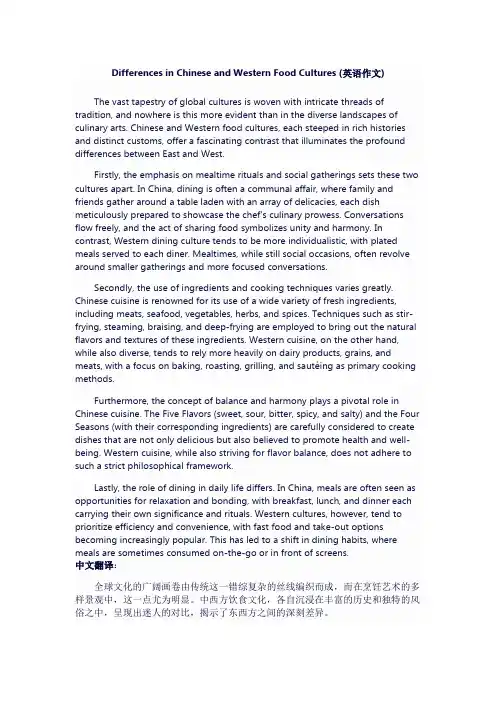
Differences in Chinese and Western Food Cultures (英语作文) The vast tapestry of global cultures is woven with intricate threads of tradition, and nowhere is this more evident than in the diverse landscapes of culinary arts. Chinese and Western food cultures, each steeped in rich histories and distinct customs, offer a fascinating contrast that illuminates the profound differences between East and West.Firstly, the emphasis on mealtime rituals and social gatherings sets these two cultures apart. In China, dining is often a communal affair, where family and friends gather around a table laden with an array of delicacies, each dish meticulously prepared to showcase the chef's culinary prowess. Conversations flow freely, and the act of sharing food symbolizes unity and harmony. In contrast, Western dining culture tends to be more individualistic, with plated meals served to each diner. Mealtimes, while still social occasions, often revolve around smaller gatherings and more focused conversations.Secondly, the use of ingredients and cooking techniques varies greatly. Chinese cuisine is renowned for its use of a wide variety of fresh ingredients, including meats, seafood, vegetables, herbs, and spices. Techniques such as stir-frying, steaming, braising, and deep-frying are employed to bring out the natural flavors and textures of these ingredients. Western cuisine, on the other hand, while also diverse, tends to rely more heavily on dairy products, grains, and meats, with a focus on baking, roasting, grilling, and sautéing as primary cooking methods.Furthermore, the concept of balance and harmony plays a pivotal role in Chinese cuisine. The Five Flavors (sweet, sour, bitter, spicy, and salty) and the Four Seasons (with their corresponding ingredients) are carefully considered to create dishes that are not only delicious but also believed to promote health and well-being. Western cuisine, while also striving for flavor balance, does not adhere to such a strict philosophical framework.Lastly, the role of dining in daily life differs. In China, meals are often seen as opportunities for relaxation and bonding, with breakfast, lunch, and dinner each carrying their own significance and rituals. Western cultures, however, tend to prioritize efficiency and convenience, with fast food and take-out options becoming increasingly popular. This has led to a shift in dining habits, where meals are sometimes consumed on-the-go or in front of screens.中文翻译:全球文化的广阔画卷由传统这一错综复杂的丝线编织而成,而在烹饪艺术的多样景观中,这一点尤为明显。
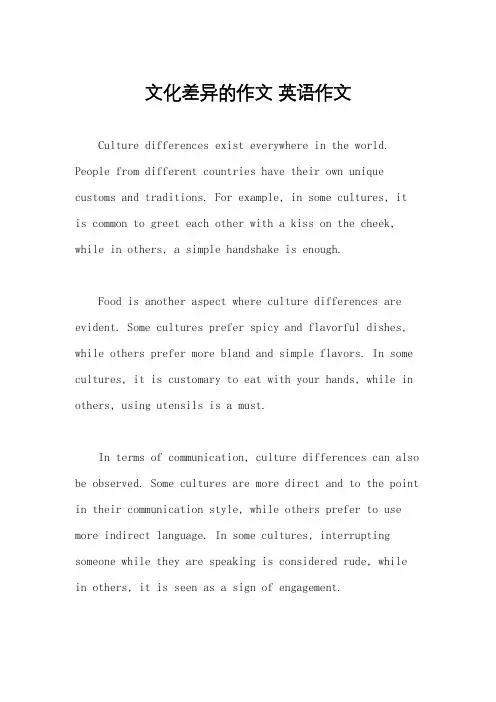
文化差异的作文英语作文Culture differences exist everywhere in the world. People from different countries have their own unique customs and traditions. For example, in some cultures, itis common to greet each other with a kiss on the cheek, while in others, a simple handshake is enough.Food is another aspect where culture differences are evident. Some cultures prefer spicy and flavorful dishes, while others prefer more bland and simple flavors. In some cultures, it is customary to eat with your hands, while in others, using utensils is a must.In terms of communication, culture differences can also be observed. Some cultures are more direct and to the point in their communication style, while others prefer to use more indirect language. In some cultures, interrupting someone while they are speaking is considered rude, whilein others, it is seen as a sign of engagement.Another area where culture differences play asignificant role is in the concept of time. Some cultures are more punctual and value time management, while others have a more relaxed attitude towards time. In some cultures, being late is unacceptable, while in others, it isperfectly normal to arrive a few minutes late.Overall, culture differences enrich our world and makeit a more diverse and interesting place. It is important to be open-minded and respectful towards other cultures, as understanding and appreciating these differences can leadto greater harmony and unity among people from all walks of life.。
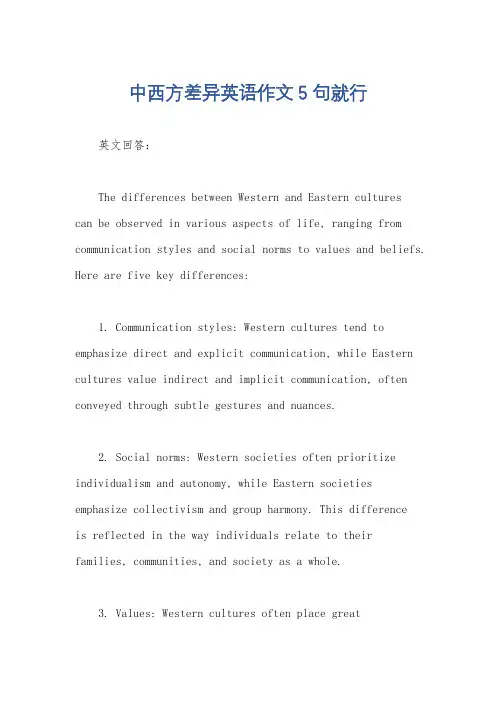
中西方差异英语作文5句就行英文回答:The differences between Western and Eastern culturescan be observed in various aspects of life, ranging from communication styles and social norms to values and beliefs. Here are five key differences:1. Communication styles: Western cultures tend to emphasize direct and explicit communication, while Eastern cultures value indirect and implicit communication, often conveyed through subtle gestures and nuances.2. Social norms: Western societies often prioritize individualism and autonomy, while Eastern societies emphasize collectivism and group harmony. This differenceis reflected in the way individuals relate to their families, communities, and society as a whole.3. Values: Western cultures often place greatimportance on material wealth, individualism, and personal achievement. Eastern cultures, on the other hand, may prioritize spiritual fulfillment, harmony with nature, and social responsibility.4. Beliefs: Western cultures have a more secular and scientific worldview, while Eastern cultures tend to be more spiritual and holistic. This difference is reflectedin religious beliefs, attitudes towards the afterlife, and the way individuals perceive the world around them.5. Art and Literature: Western art and literature often emphasizes realism, individualism, and the expression of personal emotions. Eastern art and literature, in contrast, may prioritize symbolism, abstraction, and the exploration of spiritual and philosophical themes.中文回答:1. 交流方式,西方文化偏向于直接明确的交流方式,而东方文化注重含蓄委婉的交流方式,往往通过细微的手势和语气来传达。
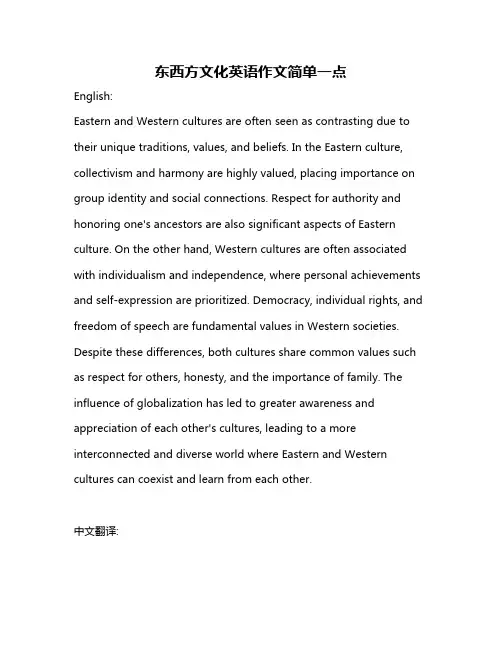
东西方文化英语作文简单一点English:Eastern and Western cultures are often seen as contrasting due to their unique traditions, values, and beliefs. In the Eastern culture, collectivism and harmony are highly valued, placing importance on group identity and social connections. Respect for authority and honoring one's ancestors are also significant aspects of Eastern culture. On the other hand, Western cultures are often associated with individualism and independence, where personal achievements and self-expression are prioritized. Democracy, individual rights, and freedom of speech are fundamental values in Western societies. Despite these differences, both cultures share common values such as respect for others, honesty, and the importance of family. The influence of globalization has led to greater awareness and appreciation of each other's cultures, leading to a more interconnected and diverse world where Eastern and Western cultures can coexist and learn from each other.中文翻译:东西方文化常被视为截然不同,这是由于它们独特的传统、价值观和信仰所导致的。
文化差异之我见英语作文Culture difference is a fascinating topic that explores the various ways in which people from different backgrounds and traditions interact with one another. 文化差异是一个十分有趣的话题,探讨了不同背景和传统的人们之间相互交流的各种方式。
One aspect of culture difference that I find particularly interesting is the way in which people express their emotions. 人们表达情感的方式在不同文化之间存在着巨大的差异。
In some cultures, emotions are openly displayed and discussed, while in others, they are kept more private. 在一些文化中,情感是公开展示和讨论的,而在另一些文化中,情感更多地被保留在私下。
For example, in Western cultures, it is common for people to express their emotions openly, whether it be joy, sadness, anger, or excitement. 例如,在西方文化中,人们通常会公开表达他们的情感,无论是喜悦、悲伤、愤怒还是兴奋。
Conversely, in Eastern cultures, there is often a greater emphasis on maintaining emotional composure and not showing one's feelings too openly. 相反,在东方文化中,更加强调保持情绪稳定,不要太公开表达自己的感情。
对待文化差异英语作文Culture differences are fascinating. It's amazing how people from different parts of the world can have such different ways of thinking and doing things. Sometimes it can be a bit shocking, but it's always interesting to learn about.When it comes to food, culture differences really stand out. Some people eat things that others would find totally gross. But it's all about what you're used to, right? Andit's cool to try new things, even if they seem weird at first.Language is another big one. It's crazy how words and phrases can mean totally different things in different places. And the way people communicate can be so different too. Some cultures are really direct, while others are more indirect and polite.Traditions and customs are also a big part of culturedifferences. The way people celebrate holidays, greet each other, or even just go about their daily lives can be so different from what we're used to. It's kind of cool to see how diverse the world is.One thing that's really important when it comes to culture differences is being open-minded. It's easy to judge or feel uncomfortable when things are different from what we're used to, but it's so much better to try to understand and appreciate the differences. It makes the world a more interesting place.。
中西方美食文化差异英语作文Title: Differences between Chinese and Western Cuisine Cultures.Well, you know, when it comes to food, it's like opening a whole new world of differences between Chinese and Western cultures. I've been around the block for over 20 years in this writing biz, but food? That's something I've been exploring all my life, just like any other foodie out there.Let's start with the ingredients. In the West, you've got a lot of dairy products. I mean, like, cheese everywhere! It's like they sprinkle it on everything. And meat, especially beef, is a big deal. You go to a Western restaurant, and there's a big, juicy steak on the menu. Hmm... But in China, we've got a whole range of ingredients that might seem a bit strange to Westerners. Take offal for example. We've got things like pig's trotters, and tripe. Some Westerners might go "Eww!" but for us, it can be a real delicacy when cooked right.Now, the cooking methods. In the West, baking is a huge thing. You've got your ovens on all the time, making bread, cakes, and roasting meats.It's like a magic box that spits out deliciousness. And frying too, butit's a bit different from Chinese frying. In China, stir - frying is an art form. You've got this hot wok, and the chef just tosses in all the ingredients lightning - fast. It makes this sizzling sound, like "sizzle - sizzle", and the smell that fills the kitchen? Oh, it's amazing. I remember one time I tried to stir - fry at home, and I ended up with a mess. I was like, "What am I doing wrong?" I thought I knew how to do it because I'd watched so many cooking shows. Well, turns out, watching and doing are two different things.Table manners are another big difference. In the West, you've got your forks and knives, and you're supposed to cut your food into small pieces and eat it. It's all very proper. But in China, we use chopsticks. And let me tell you, using chopsticks is not as easy as it looks for some people.I've seen some Western tourists struggle with them, and it's kind of cutein a way. There's a story I heard, not sure if it's true or not, but they say that some Westerners thought chopsticks were just for decoration atfirst when they saw them on the table. Ha!Presentation of food is also different. Western food often looks very neat and tidy on the plate. You've got your food arranged in a certain way, like a little work of art. In China, we also care about presentation, butit's more about the overall harmony of colors and shapes. And sometimes, we like to have a big, shared plate in the middle of the table, and everyone just digs in. Some Westerners might find this a bit unhygienic, but it'sall part of our culture.I don't know if you've ever thought about this, but the eating times are different too. In the West, dinner can be as late as 8 or 9 pm. In China, we usually have dinner earlier, like around 6 or 7 pm. I wonder why that is? Maybe it has something to do with our different lifestyles.There are also some interesting food traditions. In the West, there's Thanksgiving with the big turkey and all the trimmings. And in China, we've got the Spring Festival with all kinds of special foods, like dumplings. Dumplings are like little pockets of joy. You can put all kinds of fillings in them, and it's a family - bonding activity to make them together.Well, I could go on and on about this. I'm probably forgetting some things, and I might even have some things wrong. But that's the beauty of it. Food culture is so vast and diverse. What do you think? Have you hadany interesting experiences with Chinese or Western food? Maybe you've got a story to share too. And who knows, maybe the differences will start to blur as the world gets more connected. But for now, these differences are what make exploring both cultures' cuisines so much fun.。
中外文化的差别英语作文English: There are various differences between Chinese and foreign cultures. One of the key differences is in the way people communicate. In Chinese culture, direct communication is often avoided in order to maintain harmony and save face. This may result in indirect communication and the use of non-verbal cues, such as facial expressions and body language, to convey messages. On the other hand, in many foreign cultures, direct and explicit communication is valued and encouraged. Another significant difference lies in the concept of time. In Chinese culture, time is often seen as circular and continuous, with less emphasis on punctuality. In contrast, many foreign cultures emphasize the importance of being punctual and adhering to schedules. Additionally, there are differences in social customs, traditions, and values, which can impact various aspects of daily life, such as greetings, dining etiquettes, and family dynamics.中文翻译: 中国和外国文化之间存在着各种差异。
中西文化的差异英语作文In China, it is common to see people slurping their noodles loudly, which is considered rude in Western culture. This reflects the difference in table manners between the two cultures.When it comes to communication, Chinese people tend to be more indirect and implicit in expressing their opinions, while Westerners are generally more straightforward and explicit in their communication style.In terms of family values, Chinese culture places a strong emphasis on filial piety and respect for elders,while in Western culture, individualism and independenceare highly valued.The concept of time also differs between the two cultures. In China, it is acceptable to be a few minuteslate for a meeting, while in Western culture, punctualityis highly valued and being late is considered disrespectful.In terms of education, Chinese students are often encouraged to memorize and recite information, while Western education places more emphasis on critical thinking and creativity.In Chinese culture, the color red is associated with good luck and happiness, while in Western culture, it is often associated with danger or passion.In Chinese business culture, building relationships and trust is crucial before any business deals can be made, while in Western business culture, the focus is often on the bottom line and making deals quickly.Overall, the differences between Chinese and Western culture are vast and can be seen in various aspects ofdaily life.。
有关中西方餐桌文化差异的英语作文全文共3篇示例,供读者参考篇1Eating Food: East vs WestHi there! My name is Emma and I'm going to tell you all about the different ways people eat food in the East and the West. It's really interesting to learn about other cultures and how they do things differently than we do. My best friend Mei is from China, and we've had so much fun sharing our experiences with each other. Let me explain some of the big differences we've noticed when it comes to mealtimes!First, let's talk about the utensils we use to eat. In the West, like in America where I live, we mostly use forks, knives and spoons. The fork is for stabbing food and bringing it to your mouth. The knife helps cut up bigger pieces into bite-sized bits. And the spoon is perfect for soupy or scoopable foods. But in many Eastern countries like China, Korea and Japan, chopsticks are the go-to utensil. Chopsticks are two thin sticks that you use to pick up food. It takes a lot of practice to get good at usingthem! Mei taught me how and at first I dropped so many peas on the floor. But now I'm a chopstick pro.Another big difference is how the food is served. In Western meals, each person usually gets their own plate with their meal already plated for them. So if I order chicken nuggets, they'll come already on my plate. But in the East, there are often shared dishes in the middle of the table that everyone takes from. So there might be a plate of dumplings or a bowl of fried rice that we all take a portion from using our chopsticks or spoon. It's a much more communal way of eating where you share from the same plates. I like that because then I get to try a little bit of everything!Speaking of sharing, in the West we tend to eat our food course by course. So we'll have an appetizer, then maybe a soup or salad, followed by the main entree, and lastly dessert if we're celebrating something special. It's very spread out over time. But in Eastern meals, everything comes out at once - all the appetizers, main dishes and sides are placed on the table at the same time. That way you can sample and nibble on different dishes as you go. I have to say, I prefer this Eastern way because I'm always too impatient to wait for each course!The types of foods are quite different too. A lot of Western food contains meat like beef, chicken or pork as the main protein. We also eat a lot of bread, cheese, and potatoes as side dishes. But in the East, the main proteins are more likely to be seafood, tofu or eggs. And instead of bread and potatoes, they'll have rice, noodles or dumplings as staple starches. Don't get me wrong - I love a good hamburger! But I have become a big fan of stir-fries, sushi and all the interesting veggie dishes we get to try in Eastern cuisine.Table manners are a little different too. In Western culture, it's considered rude to burp, slurp your food or make loud chewing noises. We're taught to eat quietly with our mouths closed. But in many Eastern cultures, slurping your noodles or letting out a burp after a meal is no big deal - in fact, it can even be a compliment to the chef that you enjoyed the food so much! At first it seemed weird to me, but now I think it's just a different way of expressing appreciation.One last major difference is that in the West, we tend to eat at a set meal time - like dinner is usually around 6 or 7 pm. But in the East, meals are more flexible and can be eaten over a longer period of time, with people coming and going from the table as they get hungry. Mei's family will often leave the dishes out onthe table for hours, snacking here and there. No one tells them they have to finish their plate or can't start eating until the whole family is seated. It's a much more relaxed way of doing meals!So those are the biggest differences I've noticed between Eastern and Western dining culture. From the utensils to the table manners to how the meals are structured, there are so many fascinating contrasts. I feel lucky to have experienced both ways of eating. Mei and I have had the best time learning about each other's food traditions and customs. It's really opened my eyes to see how people in different parts of the world live their day-to-day lives. Ultimately, food is much more than just feeding your hunger - it's about bringing people together, celebrating your heritage, and making memories around the table. No matter where you're from, isn't that what mealtimes are all about?篇2Eating Across CulturesHave you ever wondered why your family eats differently than your friends' families? Maybe you've noticed some fun and interesting differences between how meals happen at your house compared to other houses you've visited. For me, I'vealways been really curious about the different dining traditions and customs around the world. You see, my family is from China, but many of my closest friends have families from the United States, Mexico, India, and other places. I've paid close attention over the years, and I've spotted some super cool differences in how we eat that I want to share with you!First, let's talk about the basics – like utensils. In my Chinese family, we always use chopsticks to eat. Chopsticks are two skinny sticks, usually made of wood or plastic, that we hold in one hand to pick up food. Using chopsticks is kind of like using tiny tongs to grab your food and bring it to your mouth. It takes a little practice to get good with chopsticks, but once you've got it down, it's really fun! A lot of my American friends, on the other hand, use forks, spoons, and knives. These seem to be the standard utensils in many Western cultures.Another big difference is the way meals are served. In China, we have what's called "family style" dining. That means that all the different dishes get placed in the center of the table, and everyone shares from those main plates by taking portions with their chopsticks onto their own individual plate. So we pass the food around and people can pick what they want from the shared dishes. But many of my friends who aren't from Chinesefamilies eat very differently – their parents often plate and serve each person an individual meal already portioned out just for them. Wild, right?Speaking of shared dishes, something I've observed is that portion sizes tend to be a bit smaller in China compared to the United States. Chinese meals usually have lots of different dishes with smaller servings of each item. That way, you can sample and share many different flavors and dishes. But I've been to friends' houses where the portion sizes are massive – like one single serving could probably feed three people! My parents have explained that in America, portions are often really big. Maybe it has something to do with all the amazing choice and abundance of food available.The rhythm and timing of meals is another fascinating difference. In my home, we spend a very long time at the dinner table just enjoying each other's company, the food, and good conversation. Dinner is a big, awesome event that we never rush through. We take our time eating different courses and dishes, and chatting throughout the experience. But I've noticed some of my friends will come home from school and their families just grab a quick solo meal or snack, and then everyone goes their separate ways. No long, dragged out family dinner times. Just afast bite and they're off to other activities right away. I've got to say, I really cherish those dinner traditions of slowing down, being together, and appreciate the meal.You know what else is distinct about Chinese meals? We tend to drink lots of hot beverages during the meal, like piping hot jasmine tea. But at plenty of my friends' houses, I've seen big glasses of ice water or cold beverages like milk or juice on the table. Having a burning hot drink with a meal seemed so bizarre to me at first! I'm just so accustomed to my parents telling me not to drink cold liquids while eating because they believe it's bad for the digestion process.One other big difference has to do with when and how we use hands versus utensils to eat. In my culture, it's considered polite to use chopsticks or utensils for everything, even foods that are handheld in other cultures like pizza, burgers, or tacos. But I've been to birthday parties and other events where my friends will happily pick up foods like that with their hands. At my household, getting your hands greasy and eating with your fingers would be seen as sloppy manners. Just goes to show how different cultures can view those habits so differently!Finally, I have to mention one other obvious contrast – the types of cuisines and dishes we eat! In China, there are so manyfamous dishes and regional specialties that you could spend years trying to sample them all. Things like dumplings, noodles, rice dishes, stir-fries with vegetables and proteins, hot pots, and so much more. Many of these items and flavors taste very different from the typical American foods and cuisines that my friends eat like hamburgers, pizza, tacos, sandwiches, and the like. But you know what? I absolutely love getting to experience and appreciate all the different incredible culinary traditions this world has to offer. It's been so fun getting to taste my way through my friends' cultures while also being proud to share my own heritage's amazing foods and customs.All in all, I feel really fortunate to have been exposed to so many fascinating dining traditions from a young age. It's given me such an appreciation for the beautiful diversity in how humans eat, bond over meals, and pass down food rituals from one generation to the next. While the specifics look quite different, I've realized that sharing food is ultimately about bringing people together across cultures and focusing on what we all have in common – a love of tasty things to eat and quality time spent bonding with loved ones. Those are some super valuable lessons that I've gotten to learn through experiencing all these different mealtime traditions firsthand. I can't wait tosee what other cool food cultures I get to explore as I travel more of this delicious world!篇3Eating Across CulturesFood is such an important part of life. We all need to eat to survive and grow big and strong. But did you know that different cultures around the world have very different ways of eating and thinking about food? I find the differences between how my family eats at home and how other families eat to be really fascinating!At my house, we eat a lot of Chinese food like rice, noodles, dumplings, and stir-fries. My grandparents emigrated here from China, so they brought all their delicious recipes and traditions with them. Whenever we have a big family meal, there are lots of different dishes served all at once. We each get a small bowl of rice, and then we use our chopsticks to take bites from the shared dishes in the middle of the table. There's almost always a soup, a vegetable dish, and then maybe a meat or seafood dish. I love dipping my dumplings in the soup!My best friend Emily's family is from Italy, and they do things quite differently at their house. Instead of having lots of dishes toshare, each person gets a big plate with just one main entree. Emily's mom always makes a vegetable side dish and sometimes bread too. But the main course is definitely the star - things like chicken parmesan, spaghetti and meatballs, or baked eggplant. They use forks and spoons instead of chopsticks too.I remember when I went over to Emily's house for dinner for the first time, I was so confused. There was only one big plate in front of me instead of the lazy susan full of shared dishes I was used to. Emily's little brother saw me looking puzzled and he laughed at me! "You eat it all yourself, silly," he said. Emily's parents thought it was pretty funny that I didn't know you're supposed to eat the whole plate by yourself in their culture.But you know what? Eating with chopsticks to pick up bites of different dishes is pretty weird for them too! Emily always gets a huge kick out of watching me use my chopsticks at lunchtime. She says it looks like I'm playing pick-up sticks with my food. One time she even tried using my chopsticks and managed to fling a mushroom clear across the cafeteria! We both cracked up laughing so hard.I've noticed there are other big differences in how our families do mealtimes too. In my family, we always say thanks and appreciate the food before eating. My mom reminds us thatsomeone worked hard to grow the ingredients and prepare the meal, so we shouldn't be wasteful. At Emily's house, they say a prayer before eating to thank God for the food instead.Another thing I find really interesting is that my family drinks stuff like tea, hot chocolate, or room temperature water with our meals. But Emily's family always has big glasses of ice water or milk with dinner. I remember gulping down some ice-cold milk at her house once and I got such a headache from the brain freeze! Now I know to take tiny sips.Dessert is different too. My family doesn't eat dessert with every meal - it's more of a sometimes treat. When we do have something sweet, it's usually just a little bite like fresh fruit or a couple bites of ice cream. Emily's family has big desserts like cake, pie, or cookies after almost every dinner though! One time they even had chocolate lava cakes AND ice cream sundaes. I was completely stuffed but somehow managed to eat both - they were too delicious to resist.You know, food is such an interesting window into how cultures around the world are alike and different. Even though certain traditions feel really weird or surprising at first, I've learned that it's just a matter of what you're accustomed to. NowI don't bat an eye when Emily picks up her fork or when I have to use a spoon. We just laugh about the funny differences.In the end, food is about sharing, nourishment, and appreciating other cultures as much as our own. Trying my friends' family's traditional dishes has opened my eyes to all sorts of new flavors I never knew about before. And you better believe they get just as excited to dig into my grandma's dumplings or Peking duck! The world has so many tasty things to offer. I feel really lucky that through food, I get to experience little bits of other cultures. It's like getting to go on around-the-world adventure, but just by eating!。
Cultural differences
There are plenty of. people in the world. They come from different countried, have their own race, belief and way of life. What is more, their culture is different from others'. So, there is no doubt that cultural difference exist among lots of countries, especially between eastern and western countries.
Compared with the way of life, eastern people always have a bath in the evening or at night in order to relax themselves after one-day's hard work while western people take a bath in the morning. so as to keep freshly for the whole day. In general, it is true, especially for Chinese people. We, Chinese people would like to take baths at night rather than in the morning. It is a kind of habits we behave all the time.
Compared with the relationships, differences are as follow: firstly, eastern people like to make friends, sometimes through their friends, parents, relatives. While western people behave a little shyly. They do not want to make friends all the time. Secondly, eastern people would like to hang out with the person they do not know about quite a lot. while western people just like going out with the person whom they get along well with. Finally, eastern people have much more friends than western people for their quite different way of getting along with. their friends. There is no doubt that eastern people are more outgoing than western people, so I agree with these a lot.
As for way of solving problems, eastern people always deal with things indirectly. They pay much attention to many things around them, and always work for a long time to solve
the problem. However, western people just go straight the heart of the problem and solve it directly and efficiently. As far as I am concerned, this difference between eastern and western people is quite normal and correct. Eastern people, especially Chinese people care about things around them a lot, they always want to satisfy everyone's need, so that they spend much more time to solve a problem than western people.
As for way of thinking, people in eastern areas usually think indirectly. They used to think about the things around them a lot and try to deal with things in a reasonable even perfect way. However, in comparison with the eastern people, people in the western areas often think directly. They pay less attention to the things around them and care much more about themselves. Honestly speaking, I disagree to this.In my opinion, everyone is special and has their right and obligations to do things. There is no need for us to critise others and what we should do is to respect their own. decision.
There are a lot of differences between eastern and western culture. These are the symbols of their own characteristics and we need time to dig out more differences so as to learn more about them. Most importantly, we must respect their culture firstly!。